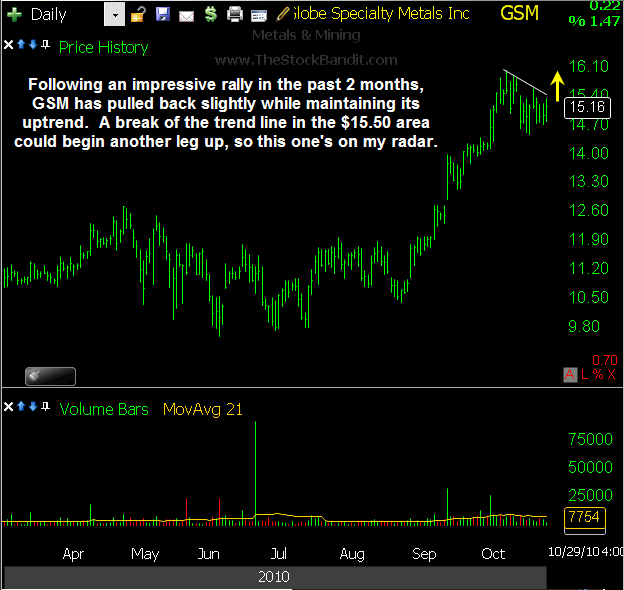Trade Like You Don’t Need the Money
December 3, 2010 at 8:07 am
 The post title says a lot, and we could probably all tape the phrase to our monitors and come away better traders.
The post title says a lot, and we could probably all tape the phrase to our monitors and come away better traders.
But let’s spend a few minutes digging a little deeper to find what it would mean to “trade like you don’t need the money.” What does that look like? What are the advantages and disadvantages of approaching your trading with this mentality?
Let’s start off by looking at some examples of people who have experienced massive success in their respective fields. That isn’t by accident, and they sure didn’t quit once they got “rich.”
Professional athletes in general make a lot of money. Many of them spend more than they make, so we’ll discard those for the sake of this discussion. There are a few superstars in every sport though, and with the global coverage most sports tend to get, they’re household names. Kobe Bryant, Derek Jeter, Peyton Manning, Tiger Woods, Roger Federer, and the list goes on. Having an 8- or 9-figure net worth is not what drives them…it’s greatness. They find fulfillment in preparing and performing in such a way that they’re the best.
There are musicians who have had the same kind of success. One of the most popular bands in the world is U2, and they had “arrived” many years ago in terms of popularity and revenue from album sales and concerts. But they kept going, kept evolving, and kept on succeeding. It’s not the money that pushes them, or else they’d have walked away long ago.
Think Record Books, Not Scoreboard
As traders, it’s so easy to become motivated by the money. Our P&L is the scoreboard that’s always right in front of us…during the day, and once the closing bell rings. We know where we stand at any moment, and that’s actually more of a hindrance to many than it is a help.
Some platforms allow you to hide profit & loss numbers, and that’s a band-aid solution which some choose to do in order to focus better on the price action and less on profits. But rather than try to treat the symptoms, why not go right to the source of the problem – your mindset.
To trade like you don’t need the money, your goals and passion have to be centered on something much bigger than money…and bigger than what that money can buy you. Your satisfaction from trading needs to be rooted in the process of attaining success.
That means you care about digging for great ideas more than booking a $1500 winner. You know if you do the former well, the latter will take care of itself.
It means you love turning off your screens at the end of the day knowing you followed your rules with discipline.
It means your undivided attention is on the market when it’s time to trade, and distractions aren’t allowed to interfere.
It means you’ll spend time doing things others won’t, like watching trading film (hat tip to @smbcapital) in order to recognize your mistakes as well as reinforce and mentally rehearse your strengths.
It means you follow other traders’ blogs and StockTwits streams only when their ideas are suited to your trading style, and you avoid all else because it becomes noise.
And it means you fuel your competitive drive day in and day out to focus on winning and nothing else. That brings with it a host of other issues, like staying out late or treating your body well, because you care about peak performance.
Trading like you don’t need the money requires passion for what you’re doing that exceeds all hopes for monetary gain. It’s a mentality of maturity whereby you realize that truly great trading will provide you with all you need and then some, and once you’ve fully accepted that, you’re able to let go of the monetary concerns and completely center your efforts on improving your process.
Put your strengths to work today with total focus, and just see what happens. If you’ll do it for a week, then a month, and build on it each day, you’ll be implementing habits which deliver all kinds of ongoing success – including money.
** If you’ve got something else to add, please share it in the comments.
Trade Like a Bandit!
Jeff White
Producer of The Bandit Broadcast
Are you following me on Twitter yet?
Options vs. Common Stock
November 17, 2010 at 11:13 am
 Traders face many hard decisions every day…buy or sell, add or lighten, stand aside or get involved. Among them is the choice between trading options or common stock.
Traders face many hard decisions every day…buy or sell, add or lighten, stand aside or get involved. Among them is the choice between trading options or common stock.
There are no doubt benefits and shortcomings of both choices, as everything literally is a trade-off.
Common is usually much more liquid, it can be traded in the after hours or premarket, and it’s by definition 100% exposure to the company. However, it is more capital-intensive since it’s not a leveraged position, which means less room for other positions in an account. Common alone is also going to carry with it greater dollar risk, as a major headline can bring tremendous gap potential.
Options are leveraged, they offer lots of versatility and possibilities (speculation, hedging, income, etc.), and they are less capital-intensive. However, liquidity is often inferior compared to common, they can’t be traded as many hours of the day as stock, and they offer only fractional exposure to the underlying stock.
The Case for Options
Options can be an excellent vehicle for trading, provided the situation is well-suited to them. The biggest 3 considerations for options are (1) the time expectation for the trade, (2) the liquidity of the options being traded, and (3) the risk involved in the trade. Let’s break those down.
Timeframe
First things first… The time you expect to be in the play is important because options will carry a bid/ask spread often times up to maybe .10-15 cents. For a stock that’s not a huge deal, but for an option which might only be trading at say $2 or lower, that’s a big percentage if you pay the spread both ways (market order getting in & out). So if you’re looking at being in a trade for at least a couple of days, that’s usually much better for an options trade than if you’re just looking to scalp it over the next half hour.
Liquidity
Second, there are quite a few stocks which have high trading volume, but for whatever reason their options are just not heavily traded. For any trade I take, whether a stock or an option, I want to feel confident there will be buyers when I go to sell, and sellers when I go to buy. Sufficient liquidity is a requirement for any trade, whether in options or common. So taking a look at the open interest, the volume, and the bid/ask spread is important in gauging the liquidity of the options. When in doubt, take a look at the highly liquid options like QQQQ, SPY, or mega-cap stocks like MSFT or INTC. That will help you get a feel for how tight the market is in the options you’re considering. You don’t ever want to be the ‘big player’ in any contract.
Risk
Third, limited risk is an advantage which options carry, such as buying put options vs. being short stock. Risk is defined with the puts, and theoretically unlimited with the short stock. Options are a great choice in particular when the stock has the potential to gap big, whether due to news coming out or simply based upon recent price history of the stock. Always consider the risk involved when weighing options vs. common, as that’s an important element of the decision-making process.
Finally, here are a few occasions to consider options rather than the common shares:
1. In front of big news (earnings, conference calls, or anything else scheduled).
2. When limited on capital (the leverage of options helps offset a limited amount of funds).
3. When the stock moves are too shaky to sit through (when a really wide stop is necessary).
4. Trade timeframe is between a couple days and a few weeks.
** If you’ve got something else to add, please share it in the comments.
Trade Like a Bandit!
Jeff White
Producer of The Bandit Broadcast
Are you following me on Twitter yet?
Trading Up from Mediocre to Great
November 8, 2010 at 12:28 pm
 Can you imagine working hard for insignificant results? Or setting your standards so low that you need not put forth effort in order to attain your goals? Never, right?
Can you imagine working hard for insignificant results? Or setting your standards so low that you need not put forth effort in order to attain your goals? Never, right?
A competitive drive pushes many traders from the inside, causing them to take on risks others wouldn’t accept. They shun the security of a regular job, opting instead to speculate in an arena filled with financial danger but unlimited upside potential. Long hours are often recorded in an attempt to gain an edge. Tedious tasks like sifting through hundreds of charts nightly, religiously reviewing results, or poring over statistics of trades past are done with the sole purpose of improvement by traders who are hungry for success.
In other words, they want it.
Those kinds of things are what it takes to get better in trading, and many are willing to pay the price. Yet far too often – unfortunately – some traders settle for less.
I’ve encountered many of them. They say things like “I’m not really trading right now because I’m waiting for XYZ to bounce back and let me out of a pretty big paper loss I’m facing.”
What’s interesting is that the ‘paper loss’ they’re referring to is quite real. Even more noteworthy is what they fail to see, which is that other trades could put them back on the right track and actually get them turning a profit again – if they’d free up their account to allow themselves to actually take those trades. Sadly, they’re just unwilling to turn loose of a mistake, so they cling to hope and wait for a miracle.
Are you one of them?
Trading Up
Often times on the road, I’m looking for an opening in the left lane to get around that slow lady ahead of me who is too busy talking on the phone to go (at least) the speed limit. In the mall, I’m amazed at how many people walk aimlessly, without a clue, as if there’s no purpose or destination to move towards. Yes, I am a bit impatient, but the point I’m making here is that it’s a habit I’m in of continually looking for ways to improve my situation.
That’s particularly true in my trading. I don’t mind putting on risk, and I realize plenty of trades will fail. What’s most important to me is to monitor how those trades move and how the stocks are behaving.
Let me be clear… It’s unrealistic to think I can foresee the moves before they happen, but it’s not difficult to recognize price action that’s outside the recent norm. And that is the key.
Studying the price action closely allows you to identify when outlier moves begin to occur, and subsequently when an exit needs to be made.
Always Think In Terms of Gain
We just sold our house. The real estate market is still soft, and for about two months we had a lot of showings but no sale. The price was too high, and we had to come off the price a bit in order to sell the house. But we’re upsizing, so what we had to concede on the last house we more than made up in the new house.
Once I thought of a price reduction in those terms, it became a no-brainer. It was less personal. Understanding that giving up $1 here might mean I save $1.50 on the next home (because it’s larger and higher-priced), logic dictated that I think in terms of what I’d gain on the other side, not solely what I’d be giving up.
Why doesn’t everyone trade this way? Why not dump an average name for a better one – one that shows more promise, more potential? Why not put in the work to get to the next level and leave mediocre results in your rearview mirror?
Make it a habit to think this way, especially if you’re gunning for improvement. OR…be complacent and stagnate, because that’s the only other option.
What has helped you learn to dump losing trades in favor of new names with better potential? Share your thoughts in the comments…
Trade Like a Bandit!
Jeff White
Producer of The Bandit Broadcast
Are you following me on Twitter yet?
Uptrend Aside, Trading Scene Set to Improve
November 1, 2010 at 10:45 am
August seems so long ago, doesn’t it? Stocks had rebounded from their July lows, briefly, and had turned back down hard for a test. The test passed, as an important higher low was established.
From there, we all know the story of how the seasonally-weak September and October stood conventional wisdom on its head to post big gains. What’s not been spoken of much, however, is the way this 2-month rally has changed in recent weeks.
What began as a rip-roaring rise ripe with short-covering has evolved into a slower, more steady uptrend channel. The pace has cooled off a bit, while still continuing to make upward progress. In fact, new intraday highs were posted multiple times last week, despite the indecision we saw between the opening and closing bells each day. Today we’re seeing more of the same, as early strength has delivered new highs while modest profit-taking has caused the indexes to back down from their best levels.
To put it another way, the “dumb money” has had great success in recent weeks. Those who waited for strength to return before becoming confident enough to join in have been fortunate enough to chase extended markets and stocks and still profit. But for those of us who prefer to see some kind of rhythm associated with market moves, it’s been a one-way street without many ways to play the long side while still protecting the downside.
Astute traders have instead found it a bit more difficult to navigate the current environment, as anyone with an ounce of discipline has felt the uneasiness of adding long-sided exposure for overnights while simultaneously recognizing the limited opportunity of trading intraday. It has left many of us to do more scalping while waiting for more lively day-to-day price action and higher-quality bases to come along. Those bases often rely on some back-and-forth price action, which we simply haven’t seen of late.
Watch The Horizon
 Any trader worth his salt knows that conditions will shift. Maybe not immediately, but eventually.
Any trader worth his salt knows that conditions will shift. Maybe not immediately, but eventually.
That doesn’t mean prediction is necessary, because it isn’t, but it does mean staying alert.
When trading well, keep doing what works but be on the lookout for signs the setup may be changing. When trading poorly, it’s imperative to employ some other methods which are more suitable to the conditions. At the same time, hope can be had that a shake-up in the price action will bring more opportunities.
Right now, the market is in an interesting spot. The rally has brought the spring highs into play as we’re essentially testing them in this area. That’s a logical resistance area that could prompt some selling, depending upon the news flow. The uptrend channels seen in the averages could easily be penetrated to the downside, heightening concerns of whether that’s the end of the run. The other side of the coin is that the trend is still up, and no evidence has surfaced to suggest it’s changing.
So as a trader, here’s how I’m dealing with all this. The trend is up, so I’m favoring the long side while keeping timeframes short in order to offset the risk of walking the highwire here. I’m also mindful of potential shifts which could emerge anytime. We’re in the midst of earnings season, and that could easily sour the mood. We have the November elections tomorrow and the political implications of that, which is a major event. And then mid-week we have the FOMC, and with all eyes on the economy, the attention of traders will definitely be on Wednesday’s announcement and policy statement.
We could ramp from here and take out the spring highs before a pullback begins. It’s possible. We could break the uptrend channels and see some selling accelerate as traders recognize the trend line break and move quickly to lock in profits. Several scenarios are possible, and it’s important to keep an open mind here for that very reason.
I will say this: I’m expecting volatility to pick up sooner than later, and that means more opportunities for trading multiple timeframes. That’s where the real money is made, as you can have capital working for multi-day moves while still maneuvering to catch intraday moves for profits. Look alive out there, this is no time to get lulled to sleep.
Trade Like a Bandit!
Jeff White
Producer of The Bandit Broadcast
Are you following me on Twitter yet?
Something Special in GSM
October 29, 2010 at 11:38 am
 Globe Specialty Metals has shown some special characteristics in the past 2 months (pardon the pun), and it may not be done yet.
Globe Specialty Metals has shown some special characteristics in the past 2 months (pardon the pun), and it may not be done yet.
Yahoo! Finance is showing an earnings reporting date of November 8, and that event could certainly prove meaningful – one way or the other. However, as a technical trader, I’m only interested in avoiding the stock on that date given the impact which such major fundamental news can have on a stock. This may not be a long-haul type of stock anyway, but with the price action of the past several weeks it deserves to be on the radar for a possible trade.
Watching for Movement
GSM is acting quite well from a technical standpoint. First, the stock has rallied big over the past two months, adding more than 50% to its value during that stretch. Second, and perhaps more importantly, it has put in some well-deserved and needed rest over the past two weeks, pulling back quietly and churning to digest its recent run.
That dip has allowed weak holders to dump shares while others have stepped in with bids to offer support. Shallow pullbacks and coiling price action also prevents the stock from becoming too extended to the upside. Momentum is good until it gets out of hand, at which point pullbacks tend to become all-out reversals. Healthy trends need rest, and this one is doing just that.
I’m looking at this one for a trade on the long side if it’s able to break out through the trend line at $15.50, and would expect a quick push up to new highs. I’ll of course look to be out of it ahead of the earnings report, as holding anything into such news is merely a gamble. On a technical basis, support has been found in the $14.50 area, and we could see momentum return if the trend line gets cleared.
Here’s a closer look at the chart of GSM for you:

Trade Like a Bandit!
Jeff White
Producer of The Bandit Broadcast
Are you following me on Twitter yet?
Narrow Your Scope With Basic Stock Filters
October 27, 2010 at 11:09 am
 Each night I work through literally hundreds of charts, aiming to find those setups with an edge. They’re the ones which allow me to not only clearly define my risks, but also offer potential profits which greatly outweigh those initial risks.
Each night I work through literally hundreds of charts, aiming to find those setups with an edge. They’re the ones which allow me to not only clearly define my risks, but also offer potential profits which greatly outweigh those initial risks.
I’m asked quite frequently by traders how I narrow down the universe of stocks to a more manageable list. The short answer is to start with price and volume filters in order to eliminate the low-dollar stocks, as well as those with poor liquidity. That alone will give you stocks to consider which aren’t as highly-speculative as penny stocks, as well as stocks which are liquid enough that there should be a buyer when you go to sell and a seller when you go to buy.
Beyond those basic filters though, you may still wish to narrow the list. In the charting program I use, dozens and dozens of additional filters are available. Among them are things such as Beta, Trade Range, Average True Range, Expanding Trade Range, Contracting Trade Range, and a lot more.
Just that brief list is enough to help locate stocks which move faster than the broad market, or to eliminate names which simply don’t move enough.
Base Filters on Broad Market Movement
 When dealing with ‘trade range’ types of filters, you can accomplish a lot. For example, you might generally use Average True Range to knock out stocks which don’t fluctuate much, helping you to eliminate the ultra-quiet stocks. When the market is starting to break out, look for Expanding Trade Range to help you locate stocks which are likely participating in the move or gaining momentum. When the market has made a big move already and is beginning to rest, use Contracting Trade Range to locate more stocks which are basing and may be starting to create patterns.
When dealing with ‘trade range’ types of filters, you can accomplish a lot. For example, you might generally use Average True Range to knock out stocks which don’t fluctuate much, helping you to eliminate the ultra-quiet stocks. When the market is starting to break out, look for Expanding Trade Range to help you locate stocks which are likely participating in the move or gaining momentum. When the market has made a big move already and is beginning to rest, use Contracting Trade Range to locate more stocks which are basing and may be starting to create patterns.
Don’t seek a one-size-fits-all filter, because it doesn’t exist. Keep an open mind, and put some thought into what it is you’re wanting to find. Stay flexible in your approach, and you’ll continually be able to avoid wasting time sifting through stocks which aren’t worth a second look.
The key to effective filtering is to learn over time how and when to vary the filter you’re using based on general market conditions. As you develop that skill, you’ll get really efficient at narrowing down the universe of stocks to a more manageable, appropriate list, depending upon whatever conditions you find yourself trading in.
Trade Like a Bandit!
Jeff White
Producer of The Bandit Broadcast
Are you following me on Twitter yet?
Stay Sharp
October 25, 2010 at 12:52 pm
 A year ago, I was in a surgeon’s waiting room. He was running late after having to do an emergency appendectomy. He hadn’t overslept or blown off his appointments for a tee time – he was operating, just as I’d expect a surgeon to.
A year ago, I was in a surgeon’s waiting room. He was running late after having to do an emergency appendectomy. He hadn’t overslept or blown off his appointments for a tee time – he was operating, just as I’d expect a surgeon to.
With scheduled surgeries on the calendar, as well as the emergencies which inevitably pop up, he wakes up every day knowing he must be on his toes. He has to be prepared for whatever comes along. Routine procedures will even occasionally throw the proverbial curve ball his way, and he’s the one that must respond accordingly for the well being of his patients.
Some of you might be surgeons, but I’m confident that all of you reading this are traders. And at this point, hopefully you know exactly where I’m going with all this.
Maintain Your Edge
As a trader, it’s important that you stay active and stay sharp. You’ll of course take vacations (hopefully of the exotic type) and have times when life calls your attention elsewhere temporarily. That’s fine, and I’m certainly not suggesting putting your trading before all else – that would be unhealthy and out of balance. I’m all for maintaining perspective and priorities. However, if you truly want to get good and continually improve, you’ve got to be in the game on a regular basis to some extent.
I attended a couple of preseason NBA games this week. During the offseason, one player in particular had just signed a huge contract. Now, preseason games don’t mean anything at all. The fans love them, of course, but they’re generally treated like scrimmages and an opportunity for teams to start developing some chemistry after a few months apart.
Watching the game, it was quite clear who’s been working hard over the summer and who probably took the mindset of “it’s a long season, I’ll eventually get sharp.” The aforementioned big-contract player was of the former attitude. It was clear he worked on his (already great) game, and he was eager to get all the playing time he could – even in a preseason, so-called meaningless game.
This guy wants it, and he shows up to play every time out. In terms of dollars, he’s long since arrived and would have a hard time spending what he’s already amassed. But money is not his sole definition of success, and it’s clear in how he plays the game.
Plan & Play to Win
As you reflect on your trading, I wonder if you’re seeing some glaring problems standing in the way of your success. Some take more time to work out, such as learning to accept a loss or understanding the times when sizing up isn’t appropriate. But if it’s just more “minutes on the court” that you truly need, that’s a much easier goal to reach…and one which will pay many dividends.
The end of the year is approaching, but it isn’t here yet. You’ve still got a couple of months before you’ll need to review 2010 and look ahead to 2011 and set appropriate goals. That time will come.
For now, you still have time to make 2010 better. You still have time to gain some momentum into the end of the year, so that you can hit the ground running when January hits. But you’ve got to look at each day as an opportunity to grow.
Let me be clear though – it won’t happen from the sidelines. You’ve got to make it a habit to be in the market regularly. Modify your timeframes if you need to, and trade small when you’re struggling to get a feel for the tape, but be active, stay sharp and on your toes.
Surgeons operate, and get their hands (gloves) dirty. Athletes play and sweat and push for improvement. Traders trade and face the pressure and find ways to grow. The best simply do not allow themselves to go cold.
Earlier this year, I completed a major trader training project which required a lot of my time. It took a few months to finish it all. I could have cut that time at least in half, but I maintained a daily devotion to trading, even in the midst of a big undertaking.
I write blog posts like this one every week, and I produce a nightly stock newsletter for subscribers over at TheStockBandit.com. I’m a husband and a dad, and trading isn’t my entire world. But I’m in the market every day, moving my money into and out of opportunities as I see them. It’s the focus of my work day, and it’s what my evening preparation points to. Staying in the game is how I stay sharp.
Are you doing the same?
Trade Like a Bandit!
Jeff White
Producer of The Bandit Broadcast
Are you following me on Twitter yet?





